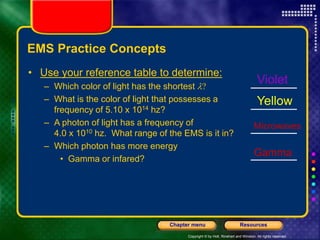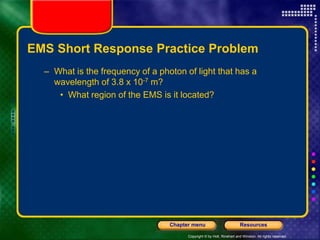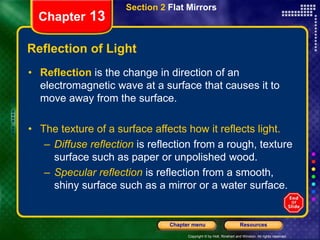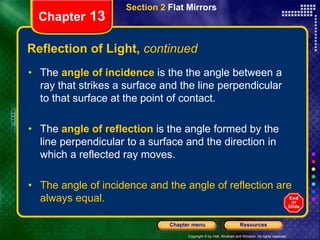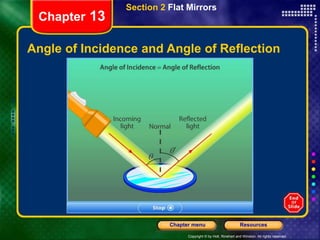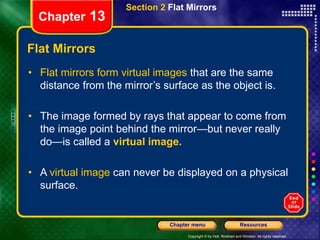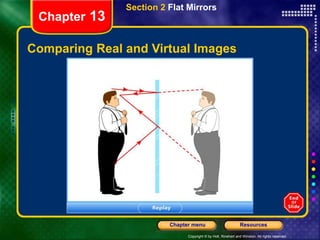HP_13_win.EMS_anvdvfdgfddfgvdfd_Reflection.ppt
- 1. Copyright © by Holt, Rinehart and Winston. All rights reserved. Resources Chapter menu Light and Reflection Chapter 13 Table of Contents • Characteristics of Light • Flat Mirrors • Color and Polarization
- 2. Copyright © by Holt, Rinehart and Winston. All rights reserved. Resources Chapter menu Section 1 Characteristics of Light Chapter 13 Electromagnetic Waves • An electromagnetic wave is a wave that consists of oscillating electric and magnetic fields, which radiate outward from the source at the speed of light. • Light is a form of electromagnetic radiation. • The electromagnetic spectrum includes more than visible light.
- 3. Copyright © by Holt, Rinehart and Winston. All rights reserved. Resources Chapter menu The Electromagnetic Spectrum High Frequency Short Wavelength High Energy Low Frequency Long Wavelength Low Energy
- 4. Copyright © by Holt, Rinehart and Winston. All rights reserved. Resources Chapter menu Chapter 13 The Electromagnetic Spectrum Section 1 Characteristics of Light
- 5. Copyright © by Holt, Rinehart and Winston. All rights reserved. Resources Chapter menu Section 1 Characteristics of Light Chapter 13 Electromagnetic Waves, continued • Electromagnetic waves vary depending on frequency and wavelength. • All electromagnetic waves move at the speed of light. The speed of light, c, equals c = 3.00 108 m/s • Wave Speed Equation c = fl speed of light = frequency wavelength
- 6. Copyright © by Holt, Rinehart and Winston. All rights reserved. Resources Chapter menu Chapter 13 Electromagnetic Waves Section 1 Characteristics of Light
- 7. Copyright © by Holt, Rinehart and Winston. All rights reserved. Resources Chapter menu EMS Practice Concepts • Use your reference table to determine: – Which color of light has the shortest l? – What is the color of light that possesses a frequency of 5.10 x 1014 hz? – A photon of light has a frequency of 4.0 x 1010 hz. What range of the EMS is it in? – Which photon has more energy • Gamma or infared? Violet Yellow Microwaves Gamma
- 8. Copyright © by Holt, Rinehart and Winston. All rights reserved. Resources Chapter menu Multiple Choice, continued 2. Which of the following statements is true about the speeds of gamma rays and radio waves in a vacuum? F. Gamma rays travel faster than radio waves. G. Radio rays travel faster than gamma rays. H. Gamma rays and radio waves travel at the same speed in a vacuum. J. The speed of gamma rays and radio waves in a vacuum depends on their frequencies. Standardized Test Prep Chapter 13
- 9. Copyright © by Holt, Rinehart and Winston. All rights reserved. Resources Chapter menu Multiple Choice, continued 2. Which of the following statements is true about the speeds of gamma rays and radio waves in a vacuum? F. Gamma rays travel faster than radio waves. G. Radio rays travel faster than gamma rays. H. Gamma rays and radio waves travel at the same speed in a vacuum. J. The speed of gamma rays and radio waves in a vacuum depends on their frequencies. Standardized Test Prep Chapter 13
- 10. Copyright © by Holt, Rinehart and Winston. All rights reserved. Resources Chapter menu EMS Short Response Practice Problem – What is the frequency of a photon of light that has a wavelength of 3.8 x 10-7 m? • What region of the EMS is it located?
- 11. Copyright © by Holt, Rinehart and Winston. All rights reserved. Resources Chapter menu Short Response, continued 13. X rays emitted from material around compact massive stars, such as neutron stars or black holes, serve to help locate and identify such objects. What would be the wavelength of the X rays emitted from material around such an object if the X rays have a frequency of 5.0 1019 Hz? Standardized Test Prep Chapter 13
- 12. Copyright © by Holt, Rinehart and Winston. All rights reserved. Resources Chapter menu Short Response, continued 13. X rays emitted from material around compact massive stars, such as neutron stars or black holes, serve to help locate and identify such objects. What would be the wavelength of the X rays emitted from material around such an object if the X rays have a frequency of 5.0 1019 Hz? Answer: 6.0 10–12 m = 6.0 pm Standardized Test Prep Chapter 13
- 13. Copyright © by Holt, Rinehart and Winston. All rights reserved. Resources Chapter menu Section 2 Law of Reflection and Flat Mirrors Chapter 13 Objectives • Distinguish between specular and diffuse reflection of light. • Apply the law of reflection for flat mirrors. • Describe the nature of images formed by flat mirrors.
- 14. Copyright © by Holt, Rinehart and Winston. All rights reserved. Resources Chapter menu Section 2 Flat Mirrors Chapter 13 Reflection of Light • Reflection is the change in direction of an electromagnetic wave at a surface that causes it to move away from the surface. • The texture of a surface affects how it reflects light. – Diffuse reflection is reflection from a rough, texture surface such as paper or unpolished wood. – Specular reflection is reflection from a smooth, shiny surface such as a mirror or a water surface.
- 15. Copyright © by Holt, Rinehart and Winston. All rights reserved. Resources Chapter menu Section 2 Flat Mirrors Chapter 13 Reflection of Light, continued • The angle of incidence is the the angle between a ray that strikes a surface and the line perpendicular to that surface at the point of contact. • The angle of reflection is the angle formed by the line perpendicular to a surface and the direction in which a reflected ray moves. • The angle of incidence and the angle of reflection are always equal.
- 16. Copyright © by Holt, Rinehart and Winston. All rights reserved. Resources Chapter menu Chapter 13 Angle of Incidence and Angle of Reflection Section 2 Flat Mirrors
- 17. Copyright © by Holt, Rinehart and Winston. All rights reserved. Resources Chapter menu Section 2 Flat Mirrors Chapter 13 Flat Mirrors • Flat mirrors form virtual images that are the same distance from the mirror’s surface as the object is. • The image formed by rays that appear to come from the image point behind the mirror—but never really do—is called a virtual image. • A virtual image can never be displayed on a physical surface.
- 18. Copyright © by Holt, Rinehart and Winston. All rights reserved. Resources Chapter menu Chapter 13 Image Formation by a Flat Mirror Section 2 Flat Mirrors
- 19. Copyright © by Holt, Rinehart and Winston. All rights reserved. Resources Chapter menu Chapter 13 Comparing Real and Virtual Images Section 2 Flat Mirrors
- 20. Copyright © by Holt, Rinehart and Winston. All rights reserved. Resources Chapter menu Section 4 Color and Polarization Chapter 13 Polarization of Light Waves • Linear polarization is the alignment of electro- magnetic waves in such a way that the vibrations of the electric fields in each of the waves are parallel to each other. • Light can be linearly polarized through transmission. • The line along which light is polarized is called the transmission axis of that substance.
- 21. Copyright © by Holt, Rinehart and Winston. All rights reserved. Resources Chapter menu Chapter 13 Linearly Polarized Light Section 4 Color and Polarization
- 22. Copyright © by Holt, Rinehart and Winston. All rights reserved. Resources Chapter menu Chapter 13 Aligned and Crossed Polarizing Filters Section 4 Color and Polarization Crossed Filters Aligned Filters
- 23. Copyright © by Holt, Rinehart and Winston. All rights reserved. Resources Chapter menu Chapter 13 Polarization by Reflection and Scattering Section 4 Color and Polarization






